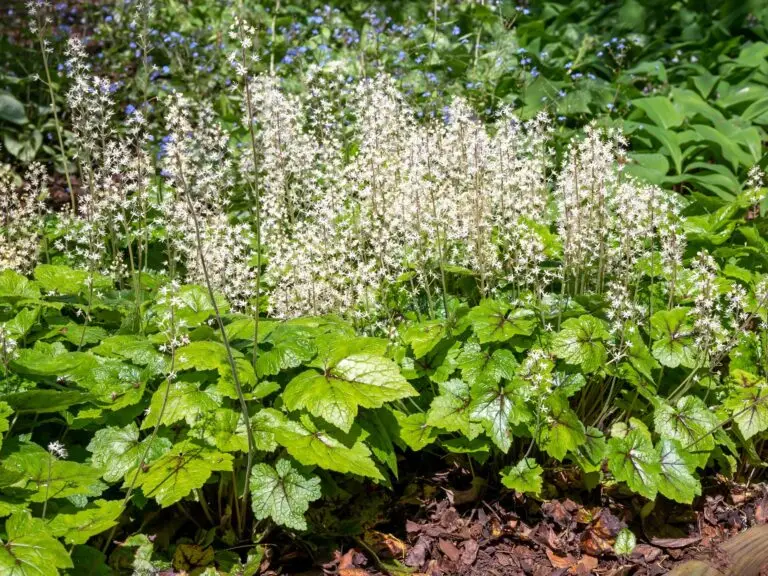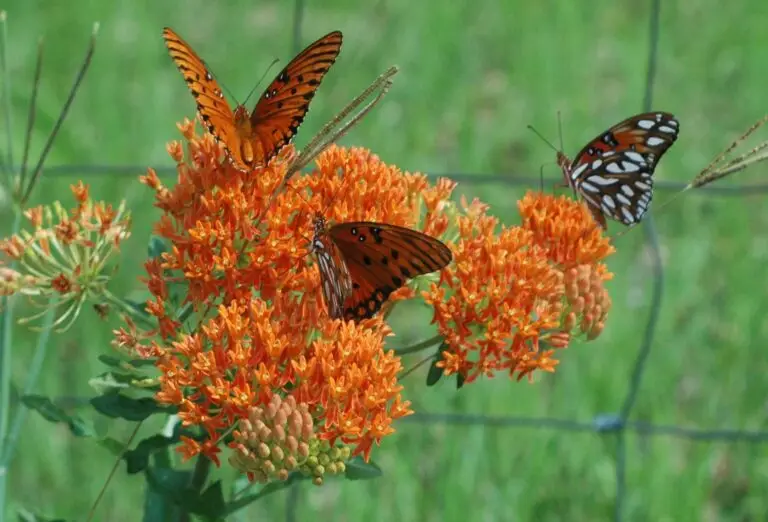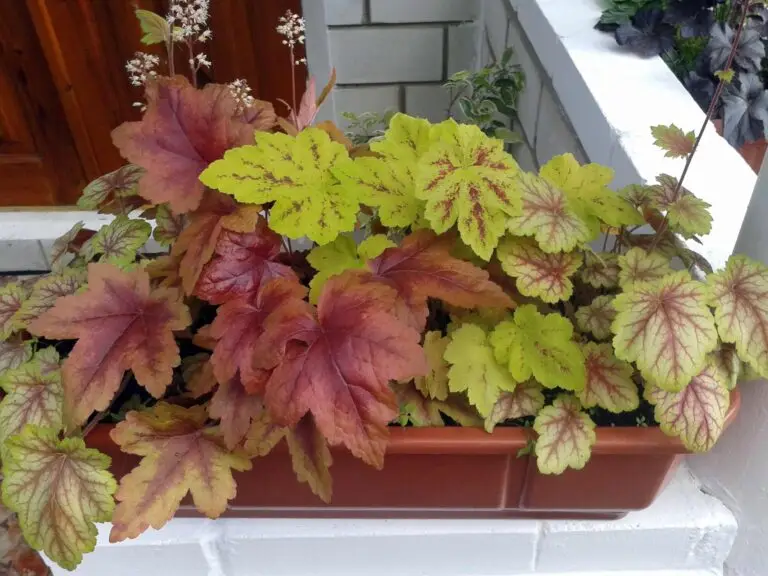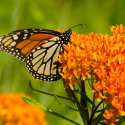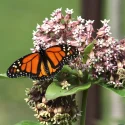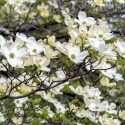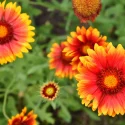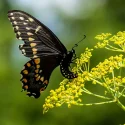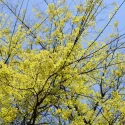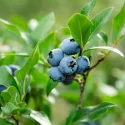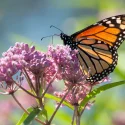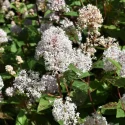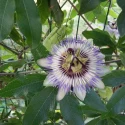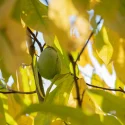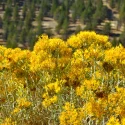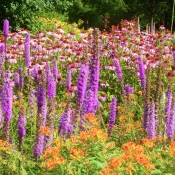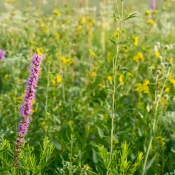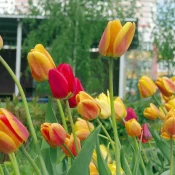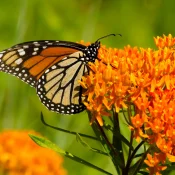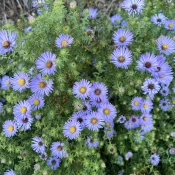I’m so overwhelmed. How do I start?
Planting a native garden doesn’t require a landscape architecture degree. Don’t be scared by zones or terms like partial shade (or partial sun?!) Let’s put aside questions about whether your soil is clay or loam.
Here are four easy steps to help get you started. These steps maximize helping butterflies and birds and minimize stress and decision-making.
Remove invasive plants
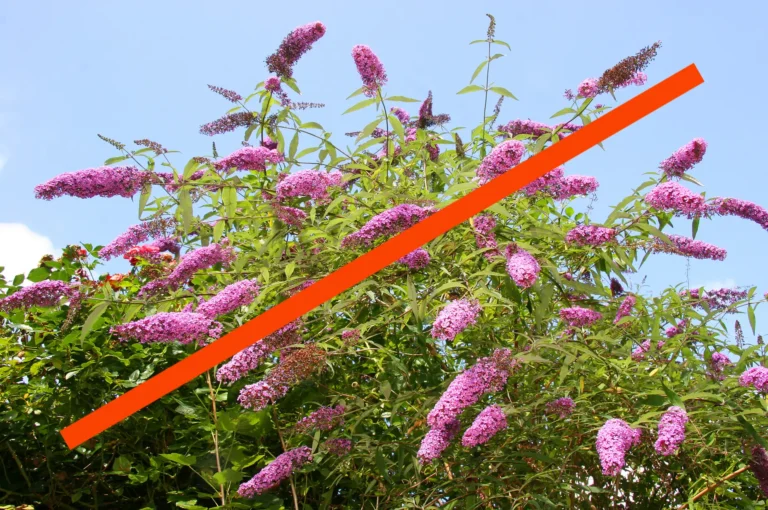
Take a walk around your yard: do you have any invasive plants? Invasive plants are plants that are non-native to your home area, yet thrive in your area. They are so successful at growing and spreading that they need to be removed before they choke out native plants, trees, and wildlife.
Sadly, lots of invasive plants are still used in landscaping. Here are some common invasive plants to remove from our gardens:
- Butterfly bush. Don’t let the name fool you!
- English ivy. Unless you are in the UK, this one needs to go.
- Mondo or Monkey Grass. Super common, super bad.
- Burning bush. Turns out its red leaves are actually a signifier of danger.
Pick a spot + meet the sun
Maybe you already have a spot in mind to plant your native garden, or you’ll replace the invasive you removed with native. If so, you know where to start.
If you don’t know where to plant, we recommend going inside and looking out the window. Where do you want a gorgeous view? That’s a great place to start your native plant garden. We spend so much of our lives inside our homes. Pick a spot where you can enjoy the garden from outside and inside, year-round.
Once you’ve found your spot, figure out the sun situation. It’s much easier than it may sound. We like Dennis Patton’s explanation from Kansas State Extension (paraphrased here):
- Full sun = areas that have no trees or buildings around them, 6+ hours of sun a day
- Part sun = edge areas: areas on the edges of trees or buildings that are not northern-facing, 3-5 hours of sun a day
- Shade = Areas always under trees or buildings or north-facing edge areas. Less than an hour of sun a day.
If you’re unsure about the sun, don’t worry! Take a picture or video of the spot and bring it to your local nursery. The staff can help you determine its location.
Plant for butterflies
It can be overwhelming to show up to a nursery or plant sale and see hundreds (if not thousands) of options available. Let’s make it easier.
Rebecca McMackin, the former director of horticulture at Brooklyn Bridge Park says it best, “the best thing to do is to plant butterfly host plants.”
What is a host plant?
A host plant is a specific plant on which a butterfly lays its eggs and its caterpillars feed. Some of us were taught as kids that caterpillars eat lots of different leaves, but that is often untrue. Many caterpillars eat only specific plants—their host plants—including beloved favorites like monarchs.
Planting for butterflies also helps birds
Planting host plants helps grow caterpillars. And caterpillars are a significant food source for birds.
You may have already heard this, but it bears repeating. Native plant hero Doug Tallamy’s research has revealed that “an incredible 6,000 to 9,000 caterpillars are required to make one clutch of chickadees.”
Yep. Six THOUSAND caterpillars for ONE chickadee nest.
You can quickly see how planting native host plants helps butterflies, birds, and the entire ecosystem in our yards and parks find balance.
Explore our butterfly plant guide and find your favorites. Once you’ve found a few you love, bring them to a native nursery or plant sale and see what’s available.
Let’s get planting!
Visit local plant nurseries, plant swaps, and plant sales, and look online to find native host plants in your area. Native plants are the secret to cheap (or even free!) gardening. There are so many ways to find native plants:
Where can I find seeds and plants?
Finding native plants can be challenging (we partly blame Marie Antoinette.) To make it easier, we’ve assembled four sourcing ideas.
Native Nursery List
300+ native nurseries makes finding one a breeze
Online Native Plant Sellers
We've included 100+ online resources to help
Society Plant Sales
Every state has a native plant society; find yours
Online Communities
Local Facebook groups are a great plant source
What if you can't find native plants at your local nursery?
Most local nurseries will order specific native plants for customers without extra charges. They often receive weekly shipments from larger wholesalers and can include your requested native plants in their orders. Speak with a nursery staff member to arrange a custom order.
Still stuck?
Plant milkweed!
Milkweed is native to every state except Alaska and Hawaii.
Milkweed is the host plant for Monarch butterflies. Monarch butterflies are endangered and need milkweed to survive. There are 100+ species of milkweed native to North America. Visit your local plant nursery; they will most certainly have milkweed.
Milkweed is very easy to plant and care for. In return, your yard will instantly be a nursery for monarch butterflies. If you’re feeling paralyzed with decisions (it happens to us all, especially parents and caregivers), it’s a no-brainer to start with milkweed.
Not for you? There are countless other ways to start, too
Maybe these steps are not what you had in mind or didn’t spark that excitement for your garden planning. Here are a few other ideas for starting your native garden:
- Take an on-demand class from Mt Cuba Center, one of America’s largest native plant gardens (located in Delaware)
- Pick native plants that birds love (some are even edible for us humans)
- If you live in the Mid-Atlantic: Explore garden plans from Edge of the Woods garden, a native plant nursery in PA (good for Mid-Atlantic gardeners)
- If you live in California: CalScape’s website includes some easy garden plans
This list could have hundreds of entries. We’ll leave it here for now and keep adding to it (email [email protected] to share content ideas).
Still feeling nervous?
We’ve been there. When we started, the Latin names, zones, acidic soil, etc. piled up quickly and led to analysis paralysis.
If this sounds like you, we have to say—
If native plants literally plant themselves—we can plant them too. Also, we lived through a worldwide pandemic. We have no reason to be intimidated by flowers.
These steps are intended to help give a framework for getting started and help get plants in the ground that can help pollinators and butterflies quickly. Planting with native plants can help return the joy, curiosity, and success that non-native landscaping can take away. It’s incredibly rewarding to become a part of nature’s ecosystem. Happy planting!
Sources
- Schwartz, John. “The Case for Gardening with Native Plants.” The New York Times, April 21, 2023. https://www.nytimes.com/2023/04/21/climate/gardening-native-plants-biodiversity.html.
- Patton, Dennis. “Defining Sun Requirements for Plants.” Johnson County K-State Research and Extension, Kansas State University. https://www.johnson.k-state.edu/lawn-garden/agent-articles/miscellaneous/defining-sun-requirements-for-plants.html.
- The Nature Conservancy. “Wisconsin Turf Grass Conversion to Native Plants Tutorial.” 2024. (PDF).
- Tallamy, Douglas. “The Chickadee’s Guide to Gardening in Your Garden, Choose Plants That Help the Environment,” March 11, 2015.
